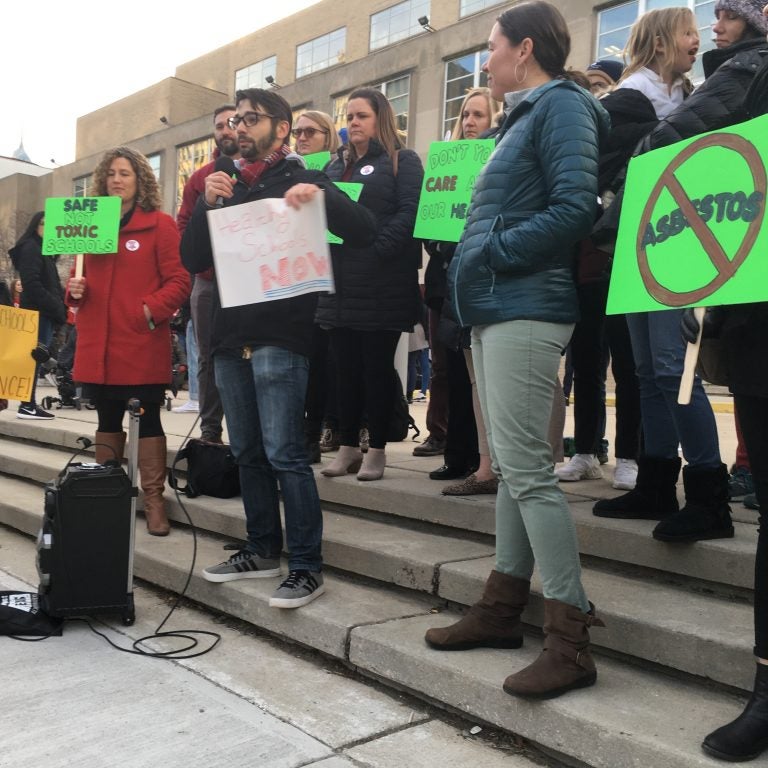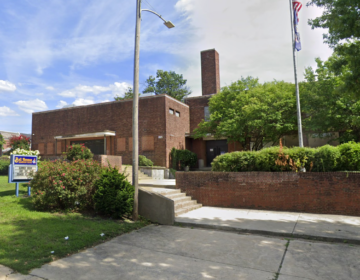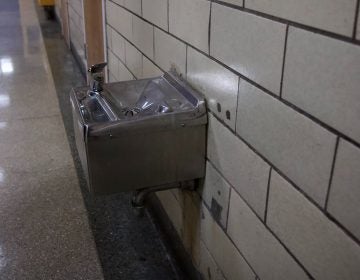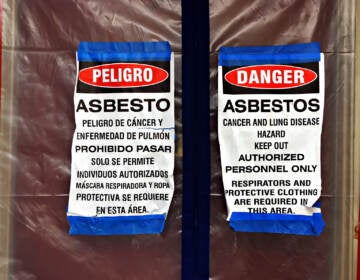Philly school board approves millions in new contracts for toxin removal
Board members, parents, teachers stress that the District must still regain trust.

Franklin Learning Center teacher Lou Fantini speaks at a rally before the start of Thursday's Board of Education meeting. (The Notebook)
This article originally appeared on The Notebook.
—
Confronted with a wave of asbestos-related complaints and school closures, the Board of Education approved millions in new contracts Thursday meant to help the Philadelphia School District rid its aging buildings of toxins.
The centerpiece is a three-year, $20 million project management contract awarded to the firm JMT to help the District better manage its major construction and renovation projects, and avoid debacles like the one that unfolded in Ben Franklin High School this fall.
The board also approved a host of other contracts, including a combined $14.2 million to expand testing and abatement, as well as $250,000 for removal supplies, and $20,000 for informational videos by a Drexel professor.
Board members assured Superintendent William Hite that he has their support in the face of rising demands for testing, cleanup, and alternative buildings for displaced students.
“Some have called for your dismissal … but I believe you are the keystone,” said board member Mallory Fix Lopez.
But board members and public speakers alike also pressed Hite to show improvement on multiple fronts, from project management to communication with school communities.
“It’s not okay that the community is left to trust the process,” said board member Mallory Fix Lopez. “We’re struggling to communicate effectively.”
“At this point the protocol should be predictable. It shouldn’t be a guessing game,” Fix Lopez said to loud applause.
Board member Chris McGinley said he supports Hite’s latest safety plan, but “it doesn’t excuse the last several months. I apologize to the teachers and the parents … we need to be better than that.”
Board chair Joyce Wilkerson defended Hite and his team. “This is not a new problem … it’s part of 30 years of neglect by the whole community,” she said. “Can we do a better job? I think we can. But I support the work the District is doing.”
But member Lee Huang, chair of the Finance and Facilities Committee, noted that the book is not closed on Hite’s performance just yet.
Huang said that the board is “impatiently” awaiting the results of an internal investigation into Hite’s handling of the Ben Franklin High fiasco, where a poorly managed reconstruction project to prepare the building for the co-location of Science Leadership Academy contaminated parts of the building with toxic dust. This forced the relocation of thousands of students from both schools, which in turn helped trigger the cascade of asbestos complaints that has lead to the closure of six schools in five buildings.
Huang said he’d spoken to the District’s Inspector General about the Ben Franklin report, and had been assured that it is “very thorough.” When he asked when the findings would be released, Huang said was told that “the investigation will take as long as the investigation takes.”
“I appreciated that response,” which suggest a thorough and detailed report, said Huang. “We are very much interested in those findings.”
Hite: Cleanup must focus on ‘occupied areas’
Thursday’s meeting began with a protest in front of District headquarters, where members of the Caucus of Working Educators gathered to demand system-wide improvements in the District’s procedures for identifying and cleaning up asbestos.
“What it took for the School District to do anything was staff and parents standing together,” said Lou Fantini, a history teacher at Franklin Learning Center, which was closed for two weeks due to asbestos.
Maintaining public pressure is essential, Fantini said. “They know that the more they look, the more they’ll find.”
Emily Seiter, a nurse at McClure Elementary, said that the District needs to clarify its reporting and repair protocols, and create a consistent system for addressing problems citywide. It’s not enough to wait for staff reports and then respond, she said. After being closed, reopened, and then closed again for a total of 17 school days, McClure is finally safe, she said, but other schools shouldn’t have to go through the same torturous process.
“It’s increasingly clear that the District has no plan in place,” Seiter said. “Yesterday we walked [back] into a building that is far safer than it was six weeks ago …. We want that work done in every school in Philadelphia.”
Inside, District officials acknowledged the frustration and pledged improvements. But Hite threw cold water on the notion that a complete removal of all asbestos will ever be possible.
“This problem is a large and complex one,” said Hite, noting that asbestos was widely used in construction until about 1980. “There’s no quick fix.”
Removing all of the District’s asbestos, including attics, basements and storage rooms, would cost about $3 billion, he said – an impossible price tag for a District already facing an estimated $4.5 billion capital backlog.
But Hite said that $125 million over the next five years would be enough to remove all asbestos from common spaces like classrooms, hallways, gyms and cafeterias. “We would prefer that no asbestos be present in any school,” said Hite, but for now, the District must focus on “occupied areas.”
Consultants now, new staff later
To help with the cleanup, the board approved a raft of new spending, with outside contractors coming into handle everything from testing and repair to project planning and management.
Huang said that spending has been inspired in part by the debacle at Ben Franklin, which revealed serious shortcomings in the Hite administration and central office staff. “The many missteps we saw really exposed some capacity issues,” Huang said.
The biggest new contract is to the construction management firm JMT, which will take the lead in handling $500 million in new capital projects – the District’s biggest capital campaign in years.
Jim Creedon, a former consultant who became Interim Chief of Facilities Management and Capital Projects after the Ben Franklin fiasco, said the JMT contract represents “a very large increase in capacity” and that the firm will help plan and oversee a wide range of projects.
Among JMT’s tasks will be to make sure every project addresses as much problematic asbestos — it is dangerous when shaken loose — and other toxins as possible, Creedon said. The firm “will also help us establish project control, monitor schedules and budgets to make sure projects are staying on track,” he said.
Creedon said that two other contracts – $3 million for cleanup and repairs, and $11.2 for testing – will allow the District to boost the number of firms doing abatement work, and respond more quickly to new problems.
Creedon also told the board that his team is currently looking at eight possible options for “backup sites” that could host displaced students. Final options will be shared at February’s board meeting, he said.
A number of public speakers criticized the Hite administration for its heavy reliance on contractors and consultants.
“You can’t consult your way out of bad leadership,” said teacher Zoe Rooney. “All these contracts, all this outsourcing needs to stop.”
Board member Huang raised a similar concern, asking Hite about his plan to upgrade the District’s “ongoing internal capacity.”
Hite responded by assuring the board that he hopes to improve on that front – with the help of another contractor.
“With the approval of this board, we subcontracted with a group from Boston, DMG, who are analyzing our systems,” Hite said. DMG’s analysis could be done as early as next week, Hite said, after which, “we plan to advertise for the positions that we would need.”
Throughout the evening, Hite sought to assure the board and the public that the District was stepping up its response to asbestos reports, but he also repeatedly reminded those present that the District’s tight budgets have always meant hard choices.
“We do not have the people power we want and need to do all the things we want to do,” he said.
Board member Julia Danzy said the asbestos problem was far bigger than Hite. “It went on under (Constance) Clayton, it went on under (David) Hornbeck,” she said, naming two former superintendents.
Removing all asbestos would mean neglecting other needs, she said. “If the School District took all the money to fix the problem, the next problem would be, ‘we can’t teach.’”
But parent Emily Pugliese said that being underfunded is no excuse for being irresponsible.
“I’m horrified,” said Pugliese, a Houston Elementary parent. “We’re talking about our kids, our city’s future, being put at risk every day just by going to school.”
If District officials want to collaborate with school communities, she said, first they need to show that they can be reliable partners. “We need to work together,” said Pugliese. “But first the District and the board need to work together to rebuild trust.”
WHYY is your source for fact-based, in-depth journalism and information. As a nonprofit organization, we rely on financial support from readers like you. Please give today.




